3-D Rarities Screening with Bob Furmanek!
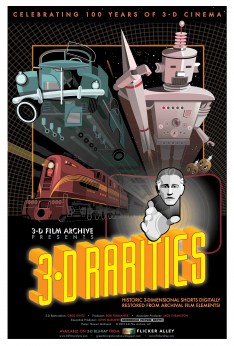
3-D Rarities Poster, courtesy of Bob Furmanek and Flicker Alley
Sunday July 19, 2015, 2:00 pm
The LA 3-D Club, Los Angeles Filmforum, and 3-D Space present
3-D Rarities Screening with Bob Furmanek!
At the Downtown Independent Theatre, 251 S. Main St. Los Angeles, CA 90012
NOTE CHANGE FROM OUR USUAL LOCATION AND TIME!
Bob Furmanek in person!
Trustin Howard, star of Stardust in Your Eyes, in person, schedule permitting
Direction to venue: http://www.downtownindependent.com/page/directions-2
For more event information: http://la3dclub.com/3-d-rarities-screening-with-bob-furmanek/
or 323-377-7238
Tickets: $10 general, $5 Filmforum and LA 3-D Club members, free for students members. Available by credit card in advance from Brown Paper Tickets at http://www.brownpapertickets.com/event/1843442 or at the door.
The first meeting of the LA 3-D Club was held on July 21st, 1955. The first documented public exhibition of a 3-D motion picture took place on June 10, 1915 at New York's Astor Theatre. The LA 3-D Club, LA Filmforum, and 3-D SPACE are proud to commemorate these important events with a very special presentation of 3-D RARITIES, an amazing collection of stereoscopic treasures dating back to the dawn of 3-D cinematography, followed by a Q&A with Bob Furmanek, founder and president of the 3-D Film Archive, and producer of these restorations. The event will take place at 2pm on Sunday, July 19th, at the Downtown Independent theater, 251 S. Main Street, in downtown Los Angeles. Tickets are on sale now at http://3drarities.bpt.me/
Films screening include: Kelley's Plasticon Pictures: THRU' THE TREES, WASHINGTON D.C., the earliest extant 3-D demonstration film from 1922 with incredible footage of Washington and New York City; NEW DIMENSIONS (aka MOTOR RHYTHM) the first domestic full color 3-D film originally shown at the New York World's Fair in May 1940; THRILLS FOR YOU, a fascinating promotional film for the Pennsylvania Railroad, first shown in 1940 at the Golden Gate International Exposition in San Francisco; BOO MOON, an excellent example of color stereoscopic animation from 1953; DOOM TOWN, a controversial anti-atomic testing film which was mysteriously pulled from theatrical release after a few play-dates in July 1953; I'LL SELL MY SHIRT, a burlesque comedy unseen in 3-D for over 60 years; THE MAZE coming attraction trailer with fantastic 3-D production design by the legendary William Cameron Menzies, and much more.
Presented in high quality digital 3-D, all films in 3-D RARITIES have been restored and mastered in 2K from original 35mm elements for optimum quality. Meticulously re-aligned shot by shot for precise registration of the original left/right elements, these historic 3-D films have never before looked this good! Special thanks to Flicker Alley!
In 1990, Bob Furmanek realized a majority of the world's 3-D film heritage was on the verge of being lost forever. In response, he founded the 3-D Film Archive, an organization dedicated to rescuing, preserving and restoring our stereoscopic heritage. Over the next two decades, Mr. Furmanek preserved over fifty 3D films, and at one point, the Archive held the largest collection of vintage stereoscopic elements in the world. Over the past two -and-a-half decades, he has worked with NBCUniversal, Paramount Pictures, MGM/Park Circus, 20th Century Fox, Warner Bros, George Eastman House, the British Film Institute, the Stanford Theater Foundation, UCLA Film & Television Archive, the Museum of Modern Art and the Academy of Motion Picture Arts and Sciences. Most recently, Mr. Furmanek helped ensure the preservation of the 1954 feature GOG, and has spearheaded the home video release of the 1966 film THE BUBBLE through Kino and his own compilation of historically-important 3D shorts entitled 3D RARITIES through Flicker Alley. This compilation has since toured the country, selling out shows at such venues as the Museum of Modern Art. www.3dfilmarchive.com
The LA 3-D Club was established in the Greater Los Angeles area in 1955 by a dedicated group of 3-D stereo photographers to further the art and science of stereoscopic photography. For six decades members have been meeting monthly to share images created through stereoscopic photography, computer generated imagery, and film and video. www.LA3DClub.com
Founded in 1975, Los Angeles Filmforum promotes a greater understanding of media art, and the role of the artists and curators who create and present it, by providing a forum for independently produced, noncommercial work which has little opportunity of reaching the general public. Filmforum is currently the longest-running venue in Southern California dedicated exclusively to the ongoing, non-commercial exhibition of independent, experimental, and progressive cinema. www.lafilmforum.org
3-D SPACE, the Center for Stereoscopic Photography, Art, Cinema, and Education, is a museum, gallery, theater, library and classroom dedicated to both the preservation of the history of stereoscopic imaging, and the advancement of current and future 3-D arts and sciences. The 3-D SPACE mission is to educate people of all ages in the art, science, and history of stereoscopy, stereography, and the principles and aesthetics of all forms of three-dimensional imaging, images and media. www.3-DSPACE.org
As a nightclub performer and movie actor, Trustin Howard used the name, Slick Slavin. When Howard segue'd into writing, Howard used his birth certificate names, Trustin Howard. My "Rarities" Film Short was his first experience in front of a movie camera. Howard went on to make about 22 Movie and TV Stints. One happened when Howard was spotted by two movie legends, Hal Wallis and Michael Curtiz, in a New Orleans Nightclub. After doing his act they told him they would like him to be in their upcoming Movie, "King Creole" starring Elvis Presley. Howard ended up introducing Elvis Presley singing "Trouble." When nightclubs closed in favor of coffee houses, Howard got into writing and ended up the head writer for the Late Night "Joey Bishop Show" on the ABC Network opposite Johnny Carson for a three-year Run. From there Ralph Edwards beckoned and Howard began writing "This Is Your Life." Some of his specific shows were Jonathan Winters, Phylis Diller, Andy Griffith, and his Milestone, Bette Davis, which was the highest rated in the series.
Kelley’s Plasticon Pictures (1922 – 1923)
Kelley’s Plasticon Pictures (1922 – 1923)
By Jack Theakston
Anticipating the release of Laurens Hammond's "Teleview" show at the Selwyn Theatre, William van Doren Kelley (Prizma, Inc., color films) booked the first widely-seen 3-D film, Movies of the Future at the Rivoli Theatre in New York City during the Christmas 1922 run of Back Home and Broke with Thomas Meighan. Released on December 23 under the "Music Films, Inc." banner—a company that produced color shorts utilizing an on-screen baton to maintain sync with the orchestra (invented by 3-D pioneer Jacob Leventhal and seen in one shot in this film)—Kelley's Plasticon short was featured alongside Music Films' Toddling Tots with the Hastings Twins. Having previously presented the first showing of a stereoscopic film in the U.S., William E. Waddell, who had produced the 3-D tests with Edwin S. Porter in 1915, was also a partner in Music Films, Inc.
Newspaper praise for Movies of the Future was quite good. "Persons accustomed to viewing ordinary flat pictures cannot easily anticipate the effect of seeing every object in the scene stand out with length, breadth and thickness as it does in life" wrote The New York Times. "They do just this, in Mr. Kelley's short film, which is composed of scenes in and about New York City." The popular program moved to the Rialto Theatre for a second week.
John Norling/Jacob Leventhal tests (1935)
John Norling/Jacob Leventhal tests (1935)
By Jack Theakston
Forming Visual Pictures, Inc. to continue Leventhal's 3-D experiments, Leventhal and John Norling shot these tests sometime in early 1935. Most of the gags are re-enactments of the most popular effects in the earlier Stereoscopiks shorts.
Locations include Riverside Drive turning onto the newly-completed George Washington Bridge (re-enacting effects seen in A Runaway Taxi), the Thunderbolt rollercoaster on Coney Island (similar to the effects seen in Luna-cy) and a baseball game in Dexter Park, Queens, N.Y., home of the Bushwick Baseball Club and the Negro Baseball League team, the Brooklyn Royal Giants. Look closely, as in one shot in the film, a black batter can be seen playing on an integrated team at least ten years before "Jackie" Robinson would play for the Brooklyn Dodgers and break segregation in the Major Leagues.
The well-rehearsed tests were enough to sell MGM short subject producer Pete Smith on the idea, and the studio released Audioscopiks on January 11, 1936. It was nominated for the best Novelty Short Subject at the 8th Academy Awards in March 1936.
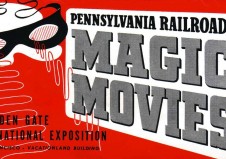
Thrills For You (May 25, 1940)
Thrills For You
By Hillary Hess
One year after visitors to the 1939 New York World’s Fair were introduced to polarized 3-D projection with Chrysler’s promotional short, In Tune With Tomorrow, the Pennsylvania Railroad gave Polaroid 3-D its west coast premiere with this film at the Golden Gate International Exposition in San Francisco.
Produced by the same team as the Chrysler film, but rather than featuring whimsical stop-motion animation, this one takes a documentary approach with careful composition in depth and dynamic point-of-view angles to impart the sensation of traveling on “the world’s most modern railroad.” Only the new polarized “magic movies” could be sufficiently modern to provide no less than five proud shots of the iconic streamlined, Raymond Loewy designed GG1 electric locomotive. Equally stunning in depth are the muscular K4 engines under full steam.
The scope of the railroad’s impressive capacity is illustrated by scenes of its freight service and maintenance facility at the legendary Altoona Pennsylvania shops. The sales pitch is at full throttle when we ride along with the Pennsy’s passengers in every type of offered luxury. And while the accommodations appear spacious enough for inside a train, one marvels at how the Norling dual-camera 35mm 3-D rig could fit inside compartments which could not possibly be as large as the camera seems to portray. Added depth is provided by the genuine landscape passing by outside the windows. No rear-projection here!
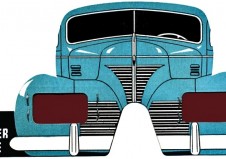
New Dimensions (May 11, 1940)
New Dimensions
By Jack Theakston
With In Tune with Tomorrow averaging over 250,000 viewers a month during the 1939-40 New York World’s Fair, Chrysler once again enlisted Loucks & Norling to top itself with yet another stereo promotional film. Expanding upon the brief animations shown in the first short, New Dimensions would be all about the Plymouth and how it was made. Shot stop-motion, full-scale and in color, John Norling had a significantly expanded budget to work with, but added challenges to the production. “Our problem in producing New Dimensions was to simulate the manufacture of a Plymouth Sedan by having each part travel to its proper place in the car without visible support,” he wrote in Business Screen Magazine. Using an overhead crane built especially for the short, the solution to hiding the wires was an old animation trick: paint the piano wires holding the parts up the corresponding background color just before each take. Using Norling’s own camera rig, red, green and blue sequential animation separations were taken through color filters mounted on the front of each lens.
A rousing score that follows the picture was the work of veteran composer George Steiner. Norling explained the timings: “Each movement was planned in advance. First, the music was written and recorded; every beat and most notes were marked off on the music track and measured exactly to the frame to provide the master synchronizing data…We followed this music score religiously in order to assure the maintenance of exact synchronism throughout the picture.”
For an 890-foot short, the picture took nine weeks to photograph, with Norling and his crew eking out nine feet of film a day at best.
Opening for the May 1940 season of the fair, New Dimensions was even more popular than its predecessor. Chrysler’s 339-seat theater was often filled to capacity, filling the peripheral vision of spectators with its 60x40-foot screen. By October 1940, an estimated 4.5 million people had seen the exhibit.
So popular was the film that it enjoyed a brief tour throughout the country after its run at the World’s Fair. In 1953, RKO Pictures picked it up for theatrical distribution, retitling it Motor Rhythm. We have restored the short from the only surviving 35mm Technicolor print which is deteriorating and shrunken with vinegar syndrome. The bookends that were cut for its re-issue came from the only known 16mm print.
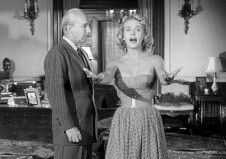
M.L. Gunzburg Presents Natural Vision 3-Dimension (November 26, 1952)
M.L. Gunzburg Presents Natural Vision 3-Dimension
M.L. Gunzburg Presents Natural Vision 3-Dimension (November 26, 1952)
By Ted Okuda
Milton Lowell Gunzburg, president of Natural Vision Corporation, supervised prominent 3-D productions, including Bwana Devil, House of Wax and The Charge at Feather River. Made as a prologue to Arch Oboler’s Bwana Devil, this short explains how Natural Vision 3-D works and is “healthy and beneficial” for your eyes. Lloyd Nolan (A Tree Grows in Brooklyn) serves as our guide, introducing us to Beany and Cecil (voiced by Daws Butler and Stan Freberg, respectively), stars of Bob Clampett’s Time for Beany television show, and Miss U.S.A of 1949 Shirley Tegge, newly-christened “Miss Third Dimension.” According to Natural Vision cameraman Lothrop Worth, this footage was shot in the library of the Berch Estate, a Beverly Hills mansion.
In October 1952, Gunzburg announced a deal with Bob Clampett and Frank Tashlin to make a feature-length Beany and Cecil movie in 3-D, though the project never materialized.
The iconic Life magazine photo of elegantly-dressed moviegoers wearing 3-D glasses depicts the audience watching this film at the world premiere of Bwana Devil in Los Angeles on November 27, 1952. Five months later, this short became the first 3-D film ever shown on television (April 29, 1953) during a test broadcast on KECA in Los Angeles.
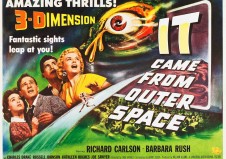
It Came from Outer Space trailer (May 23, 1953)
It Came from Outer Space trailer
It Came from Outer Space trailer (May 23, 1953)
By Ted Okuda
It Came from Outer Space, Universal-International’s first science-fiction movie, remains one of the most highly-regarded of all 3-D films. Directed by Jack Arnold (Creature from the Black Lagoon, The Incredible Shrinking Man) and based on a story by Ray Bradbury (The Martian Chronicles, Fahrenheit 451, The Beast from 20,000 Fathoms, The Illustrated Man), this seminal aliens-are-among-us thriller ranks alongside the finest sf films ever made.
Although photographed for the standard ratio of 1.37:1, It Came from Outer Space was the first 3-D feature to be shown in major cities in widescreen at 1.85:1, and was only the second feature released in three-channel stereophonic sound. (The first was Fort Ti.)
This was also the first trailer actually made in 3-D to promote a 3-D feature, and includes the super-rare tag for the first musical featurette in 3-D, Nat "King" Cole and Russ Morgan and his Orchestra, the short that accompanied It Came from Outer Space. (Universal offered exhibitors “the First All 3-D Program.”)
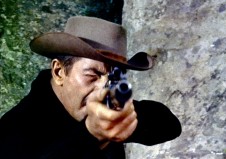
Hannah Lee trailer (June 19, 1953)
Hannah Lee trailer
By Julian Antos
There is a certain poetry inherent in a trailer for a total flop of a film. “We have a very fine picture,” says John Ireland in the trailer for Hannah Lee, the 1953 Western he starred in, directed, and co-produced, and his sense of discomfort is so transparent that you might just want to believe him out of sympathy.
Ireland wasn’t lying: Hannah Lee is indeed a fine picture, but one saddled with financial and technical problems and public controversy. Independently produced by Jack Broder, it opened to reviews that accused the film of being incomprehensible, with 3-D effects that were “Well below what has been seen in other 3-D films thus far” according to Exhibitor magazine.
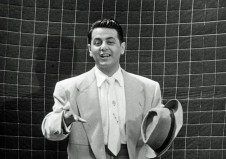
Stardust in Your Eyes (June 24, 1953)
Stardust in Your Eyes with Slick Slavin
By Ted Okuda
Shot by producer-director Phil Tucker in May 1953 as an opening for his 3-D cult favorite Robot Monster, Stardust in Your Eyes showcases “My Heart is Owned and Operated By You,” a song composed by nightclub comic Slick Slavin—misspelled “Slaven” in the credits—who is actually Trustin Howard, a respected comedy writer (The Joey Bishop Show), actor (Career, King Creole, The Bride and the Beast), composer (he wrote the classic rockabilly title song for 1958’s Speed Crazy and also sang it in the film) and author (Winchell and Runyon: The True Untold Story)—and highlights his impressions of Cary Grant, Jimmy Stewart, Ronald Colman, James Cagney, Humphrey Bogart, Larry Parks as Al Jolson (a great in-joke for movie buffs), Peter Lorre, Sydney Greenstreet and Charles Laughton. This delightful standup routine has proven to be a big hit at 3-D festivals.
Tucker caught Slavin’s nightclub act while vacationing in Alaska. Duly impressed, Tucker gave him his business card; when Slavin showed up at the Hollywood casting call for this short, Tucker immediately hired him. Stardust in Your Eyes was filmed in a single take in front of an outdoor backdrop. A seasoned pro, Slavin effortlessly ad-libs when the sound of a plane flying overhead threatens to disrupt his performance.
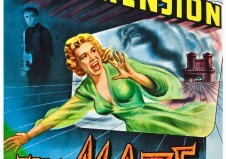
The Maze trailer (June 30, 1953)
The Maze trailer
By Ted Okuda
Directed by William Cameron Menzies (Invaders from Mars, Things to Come), who also served as production designer, The Maze is a wild mixture of mystery, horror and science-fiction elements, all wrapped up in glorious 3-D. A modestly budgeted effort from Allied Artists (formerly Monogram Pictures), the film benefits tremendously from Menzies’ technical expertise, as he uses shadow, lighting and inventive set designs to evoke a chilling, atmospheric mood.
Menzies filmed the 3-D trailer footage with lead star Richard Carlson (It Came from Outer Space, Creature from the Black Lagoon) on April 29, 1953. Menzies also filmed two 3-D shorts in late February 1953: Acrobaticks and Fun in the Sun. They were to be part of producer Sol Lesser's never-completed feature The 3-D Follies, and are now lost.
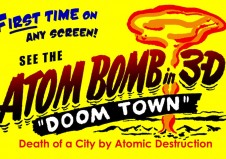
Doom Town (July 2, 1953)
Doom Town
By Ted Okuda
The first 3-D documentary, Doom Town was made by independent producer Lee Savin, who was intrigued by the atomic-bomb tests at Yucca Flats in Nevada. Filming began March 17, 1953. Photographed with the Dunning Three-Dimensional Process, it captured the devastating effects of an atomic blast.
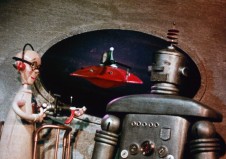
The Adventures of Sam Space (September 1960)
The Adventures of Sam Space (September 1960)
By Ted Okuda
“Takes YOU on a Thrilling Flight through Time and Space!”
In trade-journal announcements (July 3, 1953), Robert Angus and James Banks, of Volcano Productions, envisioned The Adventures of Sam Space as the first in a series of theatrical 3-D puppet cartoons, utilizing the animation seen in George Pal’s Puppetoons. In fact, writer-director Paul G. Sprunck had worked on the Puppetoons and similar shorts. He also designed the character of Sam Sawyer in 1950 for Sawyer’s Inc.
After completion, it went unreleased, a victim of the dying 3-D market. In September 1960, Banks sold it to producer Edward L. Alperson. Re-titled Space Attack, it was released as a “Special Added Attraction” with Alperson’s September Storm, the last dual-35mm 3-D feature.
